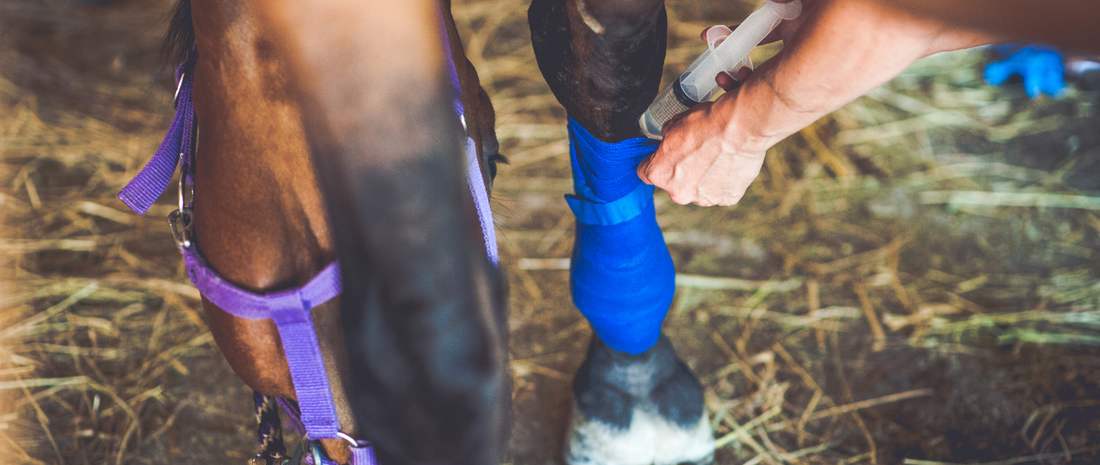
Building the Perfect Equine First Aid Kit
Share
Be Ready for Anything
When it comes to horse care, being prepared can make all the difference. Accidents, scrapes, swelling, or colic symptoms can happen fast—and often when you least expect them. That’s why having a well-stocked equine first aid kit isn’t just a recommendation—it’s a necessity.
Whether you're a weekend trail rider or a seasoned competitor, here’s how to build the perfect equine first aid kit to help keep your horse safe and cared for in any situation.
The Essentials: What Every First Aid Kit Should Include
Let’s start with the basics. These are the must-haves for any equine first aid kit, no matter your discipline.
1. Wound Care Supplies
- Sterile saline or wound flush for cleaning cuts and scrapes
- Antiseptic solution (such as Betadine or chlorhexidine)
- Antibiotic ointment (like triple antibiotic or a vet-approved alternative)
- Non-stick gauze pads and sterile dressings
- Vet wrap or cohesive bandage wrap
- Adhesive tape
- Bandage scissors with blunt ends
2. Tools and Instruments
- Digital thermometer (normal horse temperature: 99.5–101.5°F)
- Stethoscope for gut sounds and heart rate
- Twitch or lip chain for restraint
- Hoof pick for removing debris
- Tweezers or forceps
3. Pain and Inflammation Management
- Bute or Banamine (only with veterinary direction)
- Cold packs or gel wraps
- Poultice or liniment for swelling or soreness
4. Colic Readiness
- Electrolyte paste or powder
- Thermometer and stethoscope
- Emergency contact list with your vet's information
5. Additional Essentials
- Latex or nitrile gloves
- Clean towels or rags
- Flashlight or headlamp
- Notebook and pen for logging symptoms
- Duct tape for hoof wraps or emergency fixes
Trailering and Travel: What to Pack on the Go
Emergencies don’t just happen at home. If you’re heading to a show, clinic, or trail ride, make sure you have a travel-ready version of your first aid kit packed in your trailer.
Trailer First Aid Kit Essentials:
- All core wound and bandaging supplies listed above
- Extra water and a clean bucket for rinsing wounds
- Thermometer and electrolyte paste
- Standing wraps or shipping boots
- Ice packs or instant cold packs
- Laminated list of emergency contacts and insurance information
- A copy of your horse’s Coggins and health certificate if traveling out of state
On-the-Trail Essentials: What to Carry With You
When you’re miles into the woods or fields, you won’t have access to your full kit. But having a compact trail first aid pack can help stabilize injuries until you get back to the barn or trailer.
Lightweight Trail Ride First Aid Kit:
- Vet wrap and gauze pads
- Small bottle of wound spray or antiseptic
- Hoof pick
- Folding pocket knife or multi-tool
- Duct tape (wrapped flat for easy carry)
- Electrolyte paste
- Nitrile gloves
- Small flashlight or headlamp
- Cell phone in a waterproof case
- Emergency contact info and GPS pin of your trailer location
Keep these supplies in a saddlebag or backpack. Even a few essentials can make a big difference if your horse slips, steps on something, or reacts to a bee sting.
Practical Tips for Managing Your Kit
- Use a sealable, waterproof container or tote to store supplies. Label it clearly and keep it accessible.
- Check your kit every six months to replace expired or used items.
- Store medications according to label instructions, especially in hot or cold conditions.
- If you travel often, keep a separate, restocked kit in your trailer at all times.
- Include a copy of your horse’s vaccination and medical records in case of emergency.
Know When to Call the Vet
A first aid kit is a valuable tool, but it’s not a replacement for professional care. Contact your veterinarian immediately if your horse experiences:
- Signs of colic
- Non-weight bearing lameness
- Deep wounds or excessive bleeding
- Fever or respiratory distress
- Any situation where you're unsure
Preparedness Gives You Peace of Mind
Having a complete and organized equine first aid kit—at the barn, in the trailer, and even on the trail—is one of the simplest ways to be proactive in your horse’s care. Emergencies may be unpredictable, but your response doesn’t have to be. Take the time to build a kit that’s tailored to your horse’s needs and your riding lifestyle—it could make all the difference.